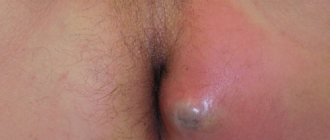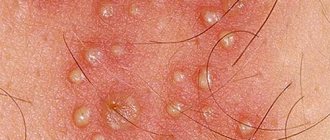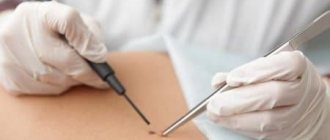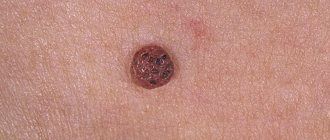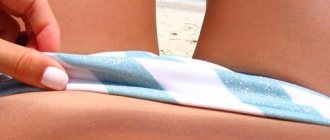No one is immune from the appearance of boils. They can appear on any part of the body. Intimate places are no exception here, since the skin here is delicate, there is enough moisture and the presence of hair. The boil itself, or popularly also called a boil, is a purulent and large pimple, very painful and causing a lot of inconvenience. If a boil appears, then it definitely needs to be treated and it is better to consult a doctor, and not let everything take its course, so that no serious problems arise.
Causes of a boil on the pubic part of the body
Doctors state that the appearance of boils begins due to an inflammatory process in the hair follicles, which is provoked by the bacteria Staphylococcus aureus, Staphylococcus aureus, and Streptococcus. Therefore, this disease very often appears in the groin area and armpits. In this case, not only the hair follicle becomes inflamed, but also the skin surrounding it. Then a large pimple appears and as it matures, pus accumulates. This process is accompanied by severe pain and itching.
The following are the main causes of furunculosis:
- Weak immune system.
- Neglect of personal hygiene.
- Poor home living conditions.
- Increased humidity (sweating).
- Drafts and hypothermia.
- Metabolism problems and poor nutrition.
- Vitamin deficiency, namely a lack of vitamins A and C.
- Diabetes.
- Cuts from shaving, abrasions and scratching.
- Perhaps there is inflammation of the Bartholin gland, the presence of trichomoniasis or gonorrhea.
All these external and internal factors can cause the appearance of boils in intimate places in both women and men, regardless of their age.
Prevention
To prevent boils from appearing, you should pay attention to the rules of hygiene, eat more of the right foods, and protect yourself from hypothermia. You should monitor minor injuries and take timely measures to heal them, otherwise germs and other infections may get there. Don't forget about vitamins that help maintain a normal immune system. Attempts at self-medication are strongly not recommended (no need to try to squeeze it out), especially since all conditions for surgical intervention must be sterile so as not to introduce another infection.
Symptoms of a boil
This disease has several stages of development, which are accompanied by such symptoms. redness appears on the pubic area or on the labia minora. You may notice swelling around the hair. Itching and discomfort appear.
severe pain occurs , because intimate places are highly sensitive than other parts of the body. The boil begins to thicken, a tubercle and swelling appear, and a pulsation is felt in the center.
The boil itself is a large pimple, it can reach 3 cm in diameter. Every day the amount of pus in it increases, and a rod matures in the middle. This disease may be accompanied by other symptoms : a rise in body temperature to 38 degrees, headache and muscle pain. If it occurs on the labia, the lymph nodes may also become inflamed, which can lead to serious consequences. Therefore, you should not delay treatment.
And at the third stage, the boil fully matures and breaks through . The tissues in the intimate places are freed from the accumulated pus and the rod that was there.
recovery begins , but you need to be very careful about hygiene in your intimate area. Despite the fact that the boil seems to be gone, the healing process is not over yet. Basically, the boil goes away in 8-12 days, but it can take longer, because this process depends on us.
But if the boil has not burst on its own after 5-7 days, then under no circumstances should you self-medicate , crush or puncture it, since microbes can enter the blood and cause serious complications; there have even been deaths. You need to urgently contact a surgeon; he will make a small incision and remove the pus. After these manipulations, the swelling will go away and the wound will heal, forming a scar.
Stages of development
The disease occurs in several stages. The ideal start for starting treatment is the first period.
Infiltration stage. The appearance of an abscess is preceded by itching and redness; later, a feeling of pain and tingling occurs at this site.
The purulent infiltrate gradually covers the entire hair follicle and adjacent tissues. Swelling may be noticeable on the skin.
Stage of suppuration. Gradually the pain intensifies and causes severe discomfort when moving. After 3-4 days, a fluctuation zone is formed.
Inside the boil, movement of purulent masses is felt, and a fistula forms on the surface.
Resolution stage. When an abscess is opened, thick pus is released, sometimes mixed with blood.
At the bottom of the abscess you can see a small greenish rod. It leaves afterwards along with pus and blood.
Healing stage. After the boil resolves, the pain goes away. Small abscesses do not leave ulcers upon opening.
Volumetric ulcers, after the contents are released, leave ulcers with a deepening into the skin. Then a scar often remains at the site of wound healing.
Treatment of a boil in an intimate place
Sometimes they advise not to do anything about a boil or boil, saying that it will go away on its own without any treatment. It may go away on its own on the back or elsewhere, but not on the pubic part, so it needs to be carefully treated as soon as the first symptoms appear.
If discomfort or mild pain occurs, you should wipe the area several times with salicylic alcohol , hydrogen peroxide or boric acid solution. During the period of boil maturation, you can apply bandages with ichthyol or erythromycin ointment . Vishnevsky ointment is also good, but because of its strong specific smell, rarely anyone wants to use it.
You can make iodine lotions , which perfectly disinfect the skin and speed up the ripening process. To do this, take a cotton swab and moisten it with iodine, apply it to the abscess and hold it there for several minutes.
To relieve pain and speed up the purulent process at home, you should warm up the problem area twice a day for 20 minutes. You need to drink brewer's yeast and a complex of vitamins; immunomodulators won't hurt either. But it is better to eat more fresh fruits, especially those that contain large amounts of vitamin C.
In advanced cases and for a quick recovery, the doctor may prescribe antibiotics . Dicloxacillin is mainly used because it belongs to the penicillin group and is excellent at fighting staphylococci. But long-acting antibiotics such as erythromycin or tetracycline may also be prescribed.
After opening the boil, it is worth continuing treatment with anti-inflammatory ointment Levomekol so that germs do not get into the wound and it heals faster. It is worth smearing problem areas with it twice a day. Also, do not forget to treat it with hydrogen peroxide.
Traditional medicine also has several tips for combating boils. To prevent their occurrence, you should drink decoctions of viburnum or wild rosemary. A compress made from baked onions or raw potatoes draws pus out of a boil well and quickly. You need to take raw potatoes and grate them on a fine grater, wrap the pulp in gauze and apply to the sore spot.
Aloe has a good anti-inflammatory and healing effect during treatment . You need to take an aloe leaf and cut it in half, apply the inside to the abscess and stick it with a breathable plaster. This procedure should be done at night, and to achieve maximum effect you will have to do about three such applications.
Another good antiseptic is fenugreek seeds . You need to pour boiling water over these seeds, and apply the resulting porridge in the form of compresses. This procedure should be done twice a day, and this compress can be kept for up to four hours.
But it is still better to consult a doctor if two or more abscesses occur, or if they do not break through for a long time. Because by treating them yourself and using various folk remedies indiscriminately and everything in a row, you can aggravate the process, which can no longer be done without surgical intervention.
Using local anesthesia, the surgeon will open the boil, drain it, and apply a gauze pad soaked in an antiseptic. And to speed up wound healing, he may prescribe physiotherapeutic procedures, such as darsonvalization, UHF, infrared irradiation, electrophoresis with copper and zinc salts.
If boils appear frequently and several at a time, this indicates a weak protective function of the body. Therefore, the doctor may recommend undergoing a course of autohemotherapy, when the patient is injected intramuscularly with his own venous blood.
How to treat a boil in the groin of men: on the penis, scrotum, testicles
At home, you can observe a boil only at the initial stage. Treatment of inflammatory processes on the genital organs in men occurs under the supervision of specialists.
General treatment methods do not differ from the above methods for women.
Men are advised to refrain from intense physical activity, heavy weight training, and hard work during treatment.
If you are interested in how chickenpox is transmitted, what is the incubation period of the disease, possible complications and preventive measures, read this article.
Instructions and reviews for Skin-Active cream with hyaluronic acid are presented in this material.
Traditional methods
Of course, independent treatment is strictly contraindicated by specialists, especially at the progressive stage of development of a purulent abscess. However, it will be quite useful to find out what traditional medicine can offer in the fight against formations in the groin area, because sometimes patients, due to embarrassment, do not dare to visit the doctor’s office for a long time.
ethnoscience
How to treat a boil at home using the most relevant folk methods:
- Mix fir oil and Vishnevsky ointment evenly and apply to the purulent abscess. Cover the top with cling film and wrap with a bandage. The compress is done at night.
- Softened raw buckwheat. Suitable for night use.
- Infusion of any anti-inflammatory herbs. You must first steam it with boiling water and let it brew for a day. Apply to the abscess and place warm clothes on top.
- Aloe leaves. Quite irrelevant, but very effective method. Soft, fresh leaves are applied to the resulting abscess. Aloe has a strong anti-inflammatory effect, so it is well suited for eliminating an abscess. Keep the leaves on the skin for several hours.
This problem needs to be taken seriously. A boil on the labia can cause many chain reactions and become a provoking cause of pathology. Therefore, it is necessary to carry out preliminary treatment with folk remedies to relieve primary symptoms and inflammation.
Types of analyzes
If you experience symptoms of a boil on your pubis, you should go to the hospital for diagnosis.
The doctor will perform a visual examination. After this, a dermatoscopy will be prescribed. A swab will also be taken to determine the pathogen. If a woman is prone to furunculosis, she needs to undergo a full diagnosis.
For this purpose the following examinations are prescribed:
- general laboratory tests of urine and blood;
- ultrasound examination of the kidneys;
- radiography;
- fluorography.
After all diagnostic examinations have been performed, the patient can be referred to doctors of related specialties.
If the inflammatory process has become severe, additional studies are prescribed:
- CT scan;
- Magnetic resonance imaging;
- blood test for sterility;
- brain puncture.
Only after this the specialist will be able to select a safe and effective therapy.
Treatment options
Today there are quite a few methods and methods of therapy, so the doctor has a choice. Depending on the condition, either surgical intervention or conservative treatment is chosen. Removal of the boil is performed under local anesthesia.
In order to speed up healing, doctors use antiseptics. If the suppuration was deep and the wound was quite serious, additional exposure using UV irradiation or electrophoresis may be required. In parallel with them, local therapy is also prescribed. This is daily treatment with furatsilin or potassium permanganate. After this, it is recommended to apply a wound healing and antimicrobial agent. When the wound begins to dry out, you can replace the ointment with a crushed streptocide tablet.
Difference from a regular pimple
An incipient boil looks like a simple pimple. Therefore, it is not given due attention. But if you look closely, you can see some differences. Such a pimple is crowned with a purulent formation almost from the first days. This does not mean that it is ripe and can be squeezed out. This is the biggest mistake. Injury to the boil leads to inflammation affecting deeper tissues. If the area around the pimple is very painful, then you should not touch it. As a rule, a week is enough for the boil to mature. There is now a lot of pus in it, and the person experiences pain due to mechanical trauma to the tissue.
Dangers
Attention! If you do not begin to treat the resulting boil in time, then there is a high probability of an abscess.
Other complications may also occur:
- Recurrence of the problem or transition to the chronic stage occurs when the wound is poorly treated or is blocked, which prevents the complete drainage of pus and lymph.
- Sepsis is an extremely dangerous complication caused by infection entering the blood and spreading throughout the body.
Antibacterial therapy
If the damaged boil has swollen to enormous sizes, then systemic therapy is no longer possible. The second point is that if they appear one after another, that is, furunculosis is diagnosed. The following antibacterial agents are most often used to treat ulcers:
- "Penicillin";
- "Erythromycin";
- "Tetracycline".
If an advanced stage is diagnosed, then dissection of the abscess is recommended. Otherwise, the infection, together with the administered drugs, will provoke severe intoxication of the body. Using this method, you can get rid of the abscess fairly quickly. This is very important when it comes to such a sensitive place as the labia or pubic area.
Possible complications
Most often, problems arise if a person begins to squeeze out a boil before it is fully ripe. The injured duct closes and bacteria rush into the tissue. A photo of a boil on intimate places is not aesthetically pleasing, but the sensation is even worse. And in order to minimize the treatment time, you need to wait with squeezing. Otherwise, you will increase the duration of treatment.
If there is a general infection, the patient will feel a sharp deterioration in his condition. The temperature rises, the person experiences weakness and headaches. This means that systemic treatment is now required. For this purpose, antibiotics are prescribed in the form of tablets for oral administration. In the most advanced cases, injections are prescribed. Do not forget that the antibiotic must be selected exactly to which the pathogen found in the smears is sensitive. Otherwise, the effectiveness may be called into question.
Why such an unusual place
This question is often asked to surgeons. Indeed, why does a boil develop in an intimate place? The main cause is staphylococcus. The pathogenic bacterium causes the inflammatory process to become deeper and more complicated. It begins in the hair follicle. In this case, not just an ordinary congestion is formed in the sebaceous gland. The formation of pus begins and a primary sac filled with it is formed. Since there is inflammation, there will be compaction, a feeling of heat in this place, as well as redness and severe pain. Quite quickly the tissue around the perimeter dies.
Consequences
In most cases, a boil in a man’s pubic area goes away without a trace, but sometimes consequences arise in which scar changes remain in the place of the former abscess. This occurs when the boil is large and there is no adequate and timely treatment.
With severe inflammation of the hair follicle, the involvement of adjacent subcutaneous fat in the process with the development of phlegmon, as well as the spread of infection to the lymphatic vessels (lymphangitis) and lymph nodes (mainly inguinal) with the occurrence of lymphadenitis, cannot be ruled out.
Inguinal lymphadenitis in a man

